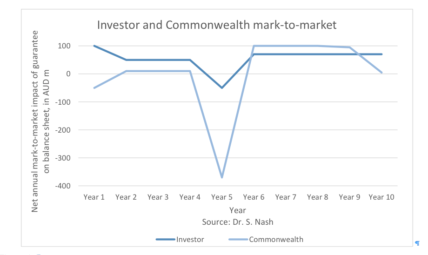Given that there is no investment currently, what is needed to get Australian institutional investors involved in Papua New Guinea? Stephen Nash, former Chief Investment Officer for Nambawan Super, examines one possible initiative: risk sharing.
Regional development is an issue in which Australia has an obvious interest. This interest could be used as a catalyst to stimulating Australian private sector investment in PNG.

Stephen Nash. Credit: BAI
Such stimulation might be achieved through the use of risk-sharing agreements. I have previously examined these arrangements as a short-term means of attracting private sector participation in regional development in order to share the burden with the public sector.
That analysis can be further developed by looking at a simple example of how such risk sharing might operate.
Aid
The Australian Government could provide aid in the form of an inexpensive risk sharing arrangement, where the difference between the commercial price of the agreement, and the actual price, would equate with the amount of aid.
It should be noted, however, that if conditions in PNG were to worsen, the short-term impact on the Australian government would also worsen.
Example
For this (simplified) example of such assistance, let us assume the following:
- face value of the senior debt investment is A$500 million (K1.27 billion),
- guarantee term on the senior debt would be 10 years,
- 80 per cent of the face of the senior debt could be guaranteed,
- the commercial price of that guarantee might be A$70 million (K178 million), which would probably block any investment,
- the Commonwealth of Australia might offer the guarantee for A$10 million (K25 million), so a saving of A$60 million (K152 million) to the institutional investor, meaning the ‘aid’ amount would be A$60 million,
- the debt might pay 10 per cent to the investor each year for 10 years,
- re-finance of the project occurs after 10 years, and,
- the guarantee would, presumably, insulate the investor from IMF haircuts and other State intervention.
Now, for purely hypothetical reasons, assume that in five years a major crisis occurs in PNG, and the country defaults, bringing in the IMF to assist.
Here, the value of the guarantee, as provided by the Australian government, might approach the face value of the obligation; or A$400 million (K1.017 billion).
‘The value of the debt gradually reverts back to par.’
Equally, the investor might write down the value of the investment, from A$500 million to near A$400 million; the value of the Australian government guarantee.
However, the cash flow up to that point, in five years, would have paid out that amount.
The investor would remain invested in the senior debt, and receive the cash flow that emerges from the infrastructure project that results from the needs of local communities for basic infrastructure items, like power.
After the crisis, ‘normality’ is presumably restored and the value of the debt gradually reverts back to par.
Impact
Using these simplified assumptions, Figure 1 below shows the approximate impact of a crisis on the guarantee provided by the Australian government over a 10-year life. It very roughly estimates the net annual impact of the guarantee—to the accounts of the investor on the one hand, and the Australian government on the other.

Figure 1 A mark-to-market estimate of the impact of a 10 year guarantee Source: Stephen Nash
Note that the hypothetical crisis causes a mark-to-market loss for the Australian government in year five, when it mainly shoulders the risk burden.
‘The choice is not between taking risk, or not.’
In contrast, the investor takes a rather small mark-to-market impact and then recovers; earning around A$50m (K127 million) on average, or roughly 10 per cent each year.
Risk
Despite all the technical mark-to-market issues, one needs to remember that the choice is not between taking risk, or not.
In the event that these risks (as described in the above mark-to-market situation) are not taken, then other regional powers will gain even more ascendency in the region.









Speak Your Mind